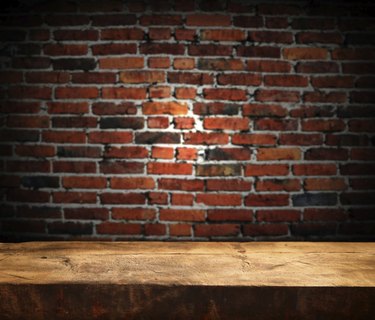Things You'll Need
Screwdriver
Orange-oil paint stripper
Synthetic and natural bristle paintbrushes
Rubber gloves
Respirator
Paint scraper
Clean rags
Sandpaper, 120-, 150- and 220-grit
Orbital sander (optional)
Stain
Primer or sanding sealer
Paint or clear finish

Some refinishing projects, including chairs, cabinets and doors, are so messy you may not want to do them yourself. A shelf is a different matter. It's small enough to place on a workbench and it's mostly flat -- two qualities that make it easy to strip and sand. Refinishing a shelf is a good way to learn the skills you need for larger projects.
Step 1
Remove all the hardware from the shelf using a screwdriver is applicable. Remove any brackets that were supporting it. Dust off the shelf so it is as clean as you can get it.
Video of the Day
Step 2
Ventilate the work area. Don rubber gloves and a respirator. Coat one side of the shelf with paint stripper using an old, clean paintbrush.
Step 3
Allow the stripper to remain on the shelf until the finish starts to bubble. Scrape it off with a paint scraper, going with the grain of the wood. use more stripper if the stripper dries out before the finish softens.
Step 4
Turn over the shelf over and strip the other side, the edges and any features such as molding or wooden brackets. Wipe the entire shelf with a damp rag when you're done. Dry the shelf with another rag. Let the shelf air-dry.
Step 5
Sand the shelf with 120-grit sandpaper using an orbital sander if the wood was stained and you want to remove the color, or rub sandpaper with the grain of the wood.
Step 6
Sand again with 150-grit sandpaper to prepare the wood for finishing. Wipe off the sanding dust with a dry rag or use tack cloth.
Step 7
Stain the wood, if desired, by painting stain on with a brush and wiping off the excess with a rag. Always wipe with the grain of the wood to prevent streaking.
Step 8
Apply a seal coat. Paint on stain-blocking wood primer with a paintbrush if you plan to paint the shelf. Apply clear sanding sealer if you plan to use a clear finish.
Step 9
Scuff-sand the seal coat with 220-grit sandpaper when it dries, which usually takes 30 minutes to an hour. Spread a coat of paint with a paintbrush. Apply a coat of clear finish. If the paint or finish is water-based, use a synthetic bristle brush to brush it. Use a natural bristle brush for spreading brushable lacquer or oil-based varnish or paint.
Step 10
Let the first coat of finish dry overnight, then apply a second coat. Repeat if necessary.
Tip
Unless you have to remove multiple coats of paint, you don't need a strong stripper. An orange-oil product should work.
Spread a little paste wax on the top and bottom of the shelf after the last coat of finish dries and buff it up with a rag to make the shelf shiny.
Warning
If you spray or paint lacquer, keep the room well ventilated and wear a mask to protect yourself from the fumes.
Video of the Day